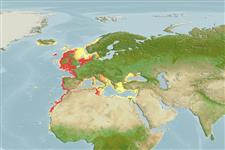Classification / Names
Common names from other countries
Main reference
Size / Weight / Age
Max length : 70.0 cm SL male/unsexed; (Ref. 4710); common length : 35.0 cm SL male/unsexed; (Ref. 5504); max. published weight: 3.0 kg (Ref. 5504); max. reported age: 26 years (Ref. 32766)
Length at first maturity
Lm 30.3 range ? - ? cm
Environment
Marine; brackish; demersal; oceanodromous (Ref. 51243); depth range 0 - 150 m (Ref. 35388), usually 10 - 60 m (Ref. 6302)
Climate / Range
Subtropical; 8°C - 24°C (Ref. 4944), preferred 16°C (Ref. 107945); 67°N - 17°N, 17°W - 37°E (Ref. 54889)
Distribution
Eastern Atlantic: southward from Trondheim Fjord (including North Sea and western Baltic) and Mediterranean Sea (including Sea of Marmara, Bosporus and southwestern Black Sea) (Ref. 4710). Elsewhere, southward to Senegal (Ref. 4710), including Cape Verde (Ref. 5304).
Countries | FAO areas | Ecosystems | Occurrences | Introductions
Short description
Dorsal
spines
(total): 0;
Dorsal
soft rays
(total): 69-97;
Anal
spines: 0;
Anal
soft rays: 53 - 80;
Vertebrae: 46 - 52. This species is distinguished by the following characters: body oval, flat and asymmetric; eyes located on right side of head, except in reversed individuals (Ref. 57416). Upper eye less than its own diameter from dorsal profile of head (Ref. 4710). Anterior nostril on blind side not enlarged (Ref. 4710, 57416), but surrounded by small rim (Ref. 57416). Its distance from front margin of head 1.5-1.9x in its distance from cleft of mouth; anterior nostril on eyed side with backward-pointing tube not or only barely reaching front border of lower eye (Ref. 4710). Preopercle covered by skin and opercle entirely scaled; mouth arched and inferior; dorsal and anal fins lacking spinous rays and united to caudal fin by well-developed membrane, but caudal peduncle distinct; dorsal fin originating on horizontal axis through upper eye; pectoral fin on eyed side asymmetrical, with 7-10 rays, and on blind side slightly shorter; straight part of lateral line visible, supratemporal part slightly arched above eyes; body covered with rectangular ctenoid scales (Ref. 57416).
IUCN Red List Status (Ref. 115185)
Threat to humans
Harmless
Human uses
Fisheries: highly commercial; aquaculture: commercial; gamefish: yes; aquarium: public aquariums
Tools
Special reports
Download XML
Internet sources
Estimates of some properties based on models
Phylogenetic diversity index
PD50 = 0.5020 many relatives (e.g. carps) 0.5 - 2.0 few relatives (e.g. lungfishes)
Trophic Level
3.2 ±0.1 se; Based on diet studies.
Resilience
Medium, minimum population doubling time 1.4 - 4.4 years (K=0.21-0.33; tm=3-5; tmax=26; Fec=100,000)
Vulnerability
Moderate vulnerability (36 of 100)
Price category
